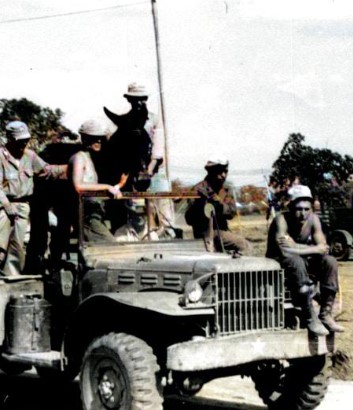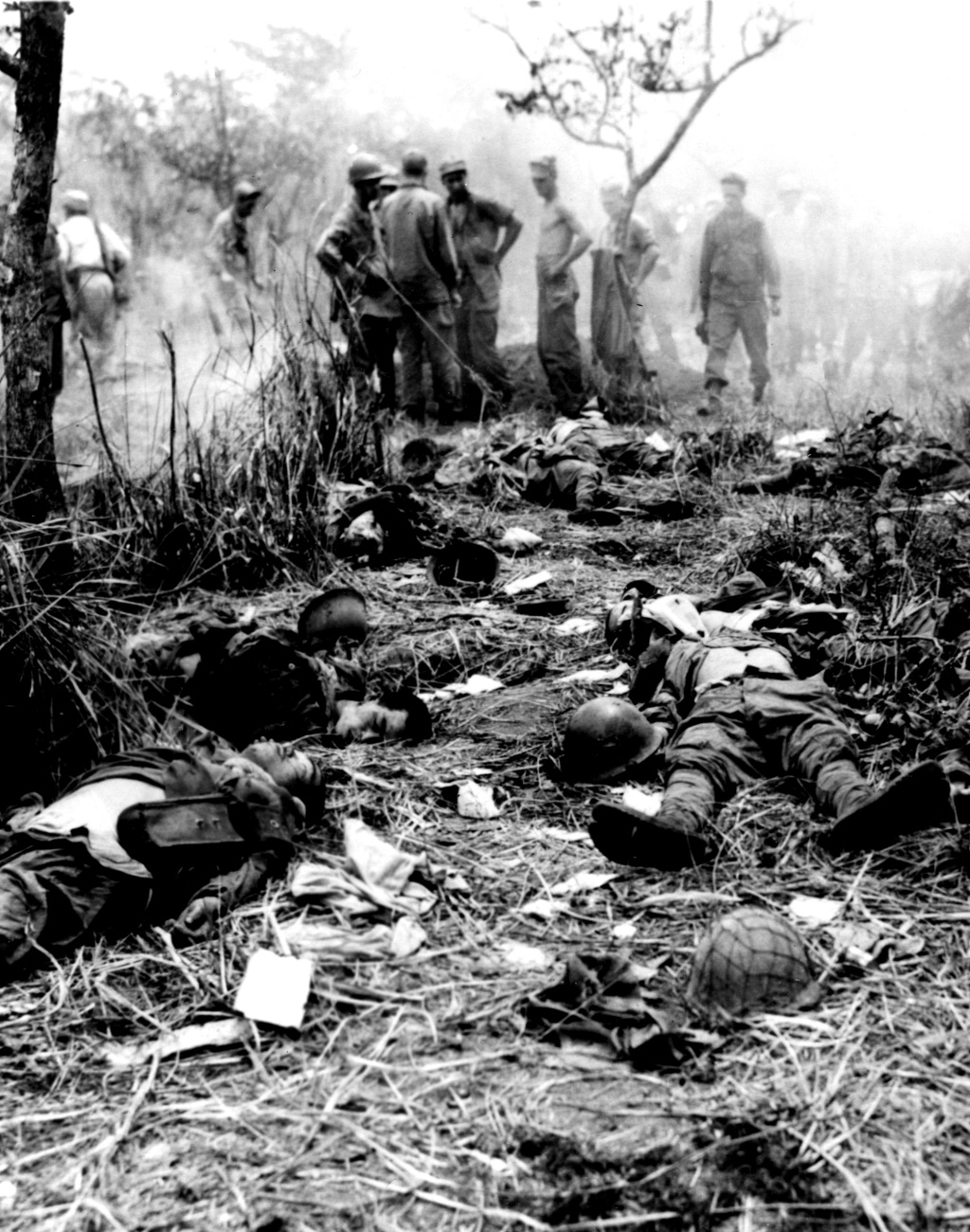THE ATTACK
The weather in that early dawn of February 2, was cold and clear; visibility was good except for a haze that clung several feet above the ground. At 0620, F and G Troops crossed the line of departure; Troop E with its four attached machine guns supported the attack from its position. ‘As skirmishers’ the formation was used by Troops F and G with two platoons forward and one back as they crossed the line of departure. The Chinese 114-IR did not jump off as scheduled. This left G Troop’s left flank exposed. The 2nd Squadron Commander with his S-3 and party were in the CP anxiously awaiting information. Troop F moved rapidly and in approximately 35 minutes was near the top of the objective. During the approach, Troop F encountered only one Japanese officer and one soldier in the draw. Lt Hyatt, F Troop Executive Officer, was wounded by a hand grenade thrown by the Jap officer before he and the Jap soldier were shot down. Lt Knight, F Troop Commander, called on the SCR 300 stating ‘other than those two Japs, looks like there’s nothing up here. The 2nd Squadron Commander directed him to turn to his right and start digging in as previously planned. It was at this time that Lt Knight came upon two pillboxes, which he destroyed using hand grenades. Then he called back to his men ‘come up, there’s a whole nest of them. Knight moved into the center of a group of mutually supporting emplacements, throwing hand grenades into the openings and firing his carbine when he could. He was initially wounded by enemy grenades and fire but kept on fighting and shouting encouragement to his men from where he lay.
A few minutes later he was killed. For his action, he was awarded posthumously the Congressional Medal of Honor. This was the only one awarded in the China Burma India Theater. Curtis Knight, 1/Sgt of F Troop, jumped in to assist his brother and was wounded by a bullet under the heart. All of F Troop kept slugging it out with the enemy who wore dug into a strong mutually supporting reverse slope position. The position was built up around a series of bunkers, manned with machine guns, foxholes, and trenches that were well concealed and developed in-depth. The platoons of F Troop continued to close in and were subjected to hand grenades, mortar fire, and machine gun fire. The 613-FAB and the 2nd Squadron’s mortars did succeed in silencing to a degree the enemy mortars located south of the objective. In general, each position had to be overcome. Cpl Hill of Troop F fired his bazooka (2.36′ rocket launcher) at one of these bunker positions. Two of the shells did not detonate, so he threw away the bazooka and charged the position. He jumped into the bunker and killed a Japanese officer and an enlisted man with his knife. F Troop succeeded in taking its objective through the courage and boldness of its officers and men. All officers in Troop F were either killed or wounded, and three were decorated for gallantry in action.
During the entire time, firing could be heard in the G Troop sector but no message had come in on the SCR-300. Throughout the morning of February 2, there was constant interference and noise in the radio reception. The 2nd Squadron Commander using information received from Troop F decided to displace Troop E forward from its position. The E Troop commander was directed to move up the center and tie in with Troop F on the right. A new reserve was immediately reconstituted from the I&R Platoon and from all available men that could be found. At about 0700, the 2nd Squadron CP started receiving intensive artillery fire from Japanese 77-MM guns which were firing from concealed positions north of the objective. This fire was continuous throughout the morning with close ones hitting the CP, but the major part of the fire fell on the old CP which had been set up as a dummy. On one occasion, when some of their salvos were coming within twenty or thirty yards of the CP, the 2nd Squadron Commander was sending a message to the executive officer asking for more ammunition for the front-line troops. The executive officer asked, ‘Did they get you ?’ The squadron commander answered, ‘No, but it was damn close’. Japanese artillery fire immediately grew in intensity. Apparently, the Japanese had people who understood English and were monitoring the net.
At about 1030, February 2, the 2nd Squadron Commander received his first message from Capt Wood, G Troop Commander, in which he stated his forward observer and radio operator from the 613-FAB had been killed and that Troop G needed artillery support. The squadron commander told him to use his radio and call for artillery fire through the artillery liaison officer, Capt Robert B. Compton, and that he would have to adjust his own fire. In short order, this arrangement for calling for artillery fire was made. Capt Wood sent another message stating that Troop G was dangerously low on ammunition and that they would have to be re-supplied before they could attack again. G Troop was quickly re-supplied with ammunition since Lt Cornwall, Executive Officer of Troop G, was up close with the ammunition mules. The squadron commander notified G Troop Commander that one platoon from Troop E with a section of machine guns would be attached to him to support his attack. This platoon was set up on the right flank of the enemy and gave flanking fire support for G Troop.
At 1200, G Troop jumped off with excellent artillery supporting fire and by 1235 it had captured the objective in its sector. Troop G in its attack ran into the same type of positions as Troop F. In overcoming these bunker positions, bazookas, as well as artillery, were effectively used. Since the supply of artillery ammunition was short, the 613-FAB found it necessary to conserve on HE ammunition and fire a number of concentrations with white phosphorus shells. It was on one of these occasions that part of these phosphorus shells fell on the southwest slope of the hill and started a brush and grass fire. The wind, which was blowing from the west, pushed the fire and smoke right through E and F Troop positions. Some Japs who were still in this area jumped up and ran into the troops’ positions only to be shot down. Troop E was not aware of the situation and for a moment believed it was receiving a counterattack, but fortunately, it wasn’t.
REORGANIZATION
Reorganization started immediately and Troops E F and G were disposed of according to plan. Since all officers in Troop F had either been wounded or killed Lt Julian Hard, the I&R Platoon Leader was placed temporarily in command of F Troop. Evacuation continued over difficult terrain from the front lines to the aid station and onto the portable surgical hospital in Mong Noi. Chinese from the 2/89-IR assisted in evacuating the wounded from the portable surgical hospital to the airstrip. The distance from the front lines to the portable surgical hospital was approximately a mile, and from the hospital to the airstrip, three miles. Ironically, one of the first men to be evacuated was Capt J.V.H. Davis, the 2nd Squadron adjutant, who had been placed in charge of the evacuation team which was formed from the Regimental I&R Platoon. Capt Davis was wounded in the arm, chest, and legs while performing his duty. At 1230, the 3rd Squadron launched a successful attack to secure critical terrain forward of its position, and this assisted in relieving the pressure which was being put on the 2nd Squadron by enemy artillery and mortar fire.
RESULTS
The mission of the 2nd Squadron was completed at 1235 on February 2, 1945. The battle had been won through the sheer boldness and aggressiveness of every individual fighting man. The cost of taking this terrain was 25 killed and 79 wounded. The importance of the 2nd Squadron’s objective as an observation post and as the key terrain of this area was not realized until the objective had been taken. From this hill, the disposition of the task force, even including the Regimental, Battalion, and Squadron CP, as well as gun positions, could be seen in detail. On February 5, it was announced on an American radio broadcast from Chungking, China, that a unit of the Mars Task Force had broken the resistance of the Burma Roadblock. On February 18, Lord Louis Mountbatten spoke to the 2nd Squadron and, as a gesture of goodwill, told the Squadron that the hill over which they had fought would in the future appear on all British maps as Knight’s Hill. The combat mission of the NCAC was completed in April 1945. The Japanese Army had been driven from northern and central Burma and land communication with China was re-established.




















